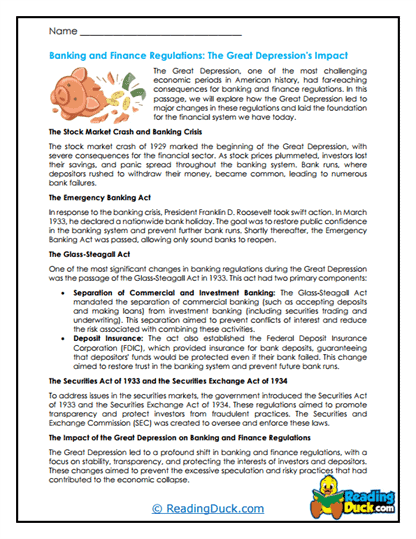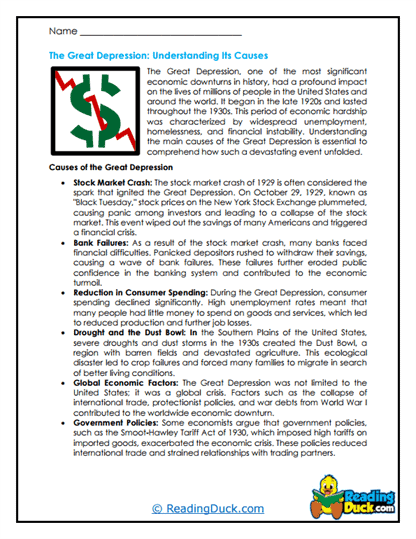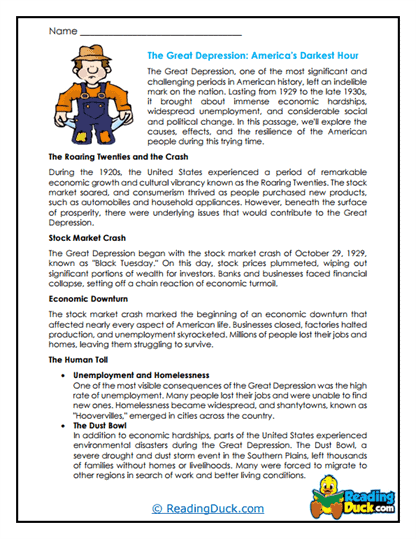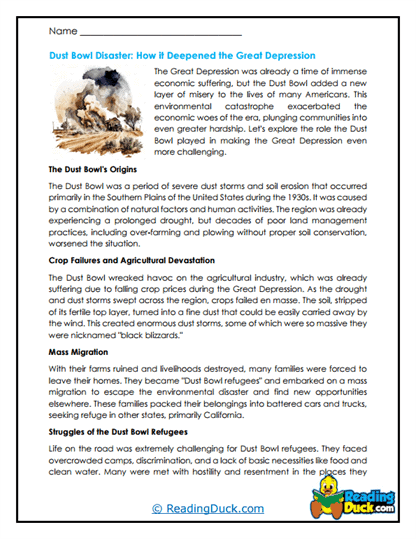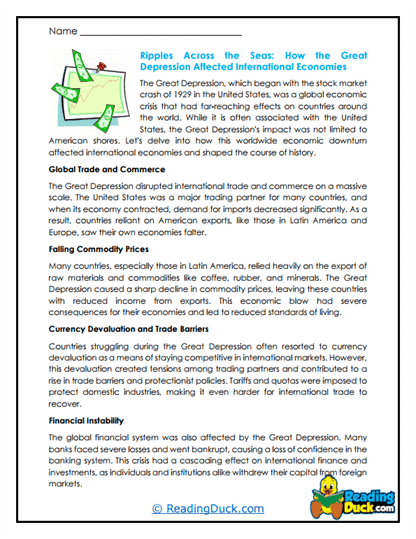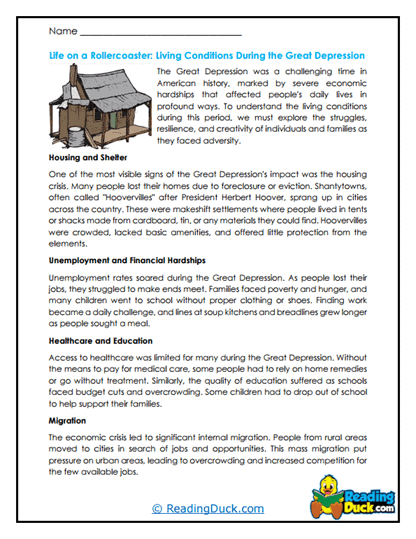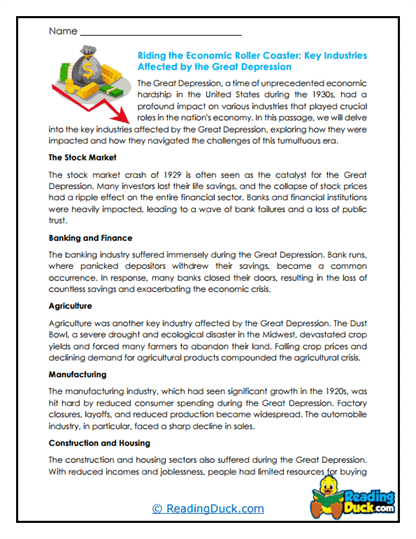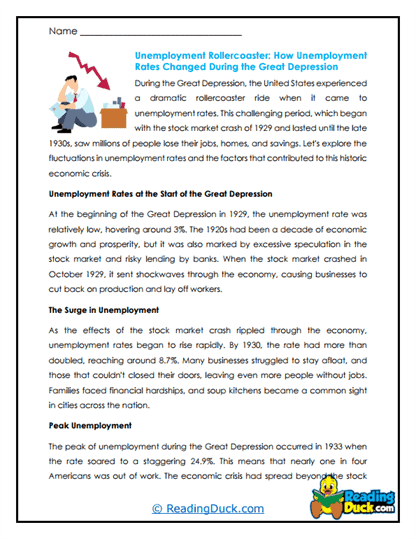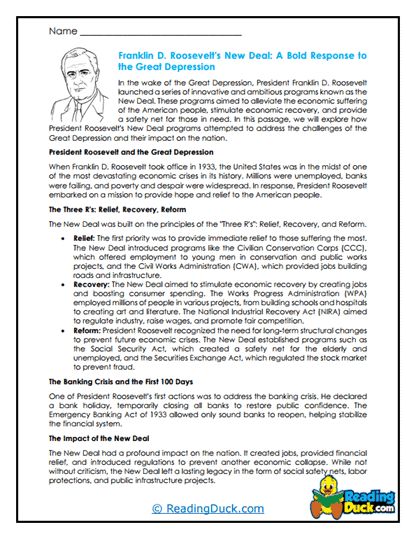Great Depression Worksheets
About Our Great Depression Worksheets
Our Great Depression worksheets offer students a thorough and engaging exploration of one of the most pivotal periods in U.S. history. The Great Depression, which spanned from 1929 to the late 1930s, dramatically reshaped American society, politics, and economics. Understanding this era is crucial for students to grasp the complexities of modern U.S. history and the enduring impacts of economic crises.
Each topic in this collection contains several worksheet sets, designed to enhance students’ understanding through a variety of activities:
- Multiple Choice Questions: These questions assess students’ comprehension of the reading passages, focusing on key events, figures, and concepts related to the Great Depression.
- Short Answer Questions: These prompts encourage students to express their understanding in their own words, fostering critical thinking and the ability to communicate historical knowledge effectively.
- Open-Ended Questions: These questions invite students to reflect on their personal interpretations, opinions, and connections to the topic, deepening their engagement with the historical content.
Each worksheet set includes an answer key to support educators in evaluating students’ understanding. All worksheets are available as PDF files, making them easily accessible for electronic viewing, downloading, and printing.
Understanding the Great Depression: A Defining Era in U.S. History
The Great Depression was a period of severe economic downturn that had far-reaching effects on American society and the global economy. It began with the stock market crash of 1929 and led to widespread unemployment, poverty, and social upheaval. This era also sparked significant government intervention in the economy, leading to the creation of programs and policies that continue to influence U.S. governance today.
Key Aspects of the Great Depression:
- The Stock Market Crash of 1929: The Great Depression was triggered by the dramatic collapse of the U.S. stock market in October 1929, often referred to as "Black Tuesday." The crash wiped out millions of dollars in investments, leading to a cascade of bank failures, business closures, and massive unemployment. Students can explore the causes and effects of the crash, including the speculative bubble that preceded it and the widespread panic that followed.
- Widespread Unemployment and Poverty: As businesses failed and banks closed, unemployment rates soared, reaching nearly 25% at the height of the Depression. Families across the country struggled to survive, with many losing their homes and savings. Students can examine the human impact of the Great Depression, including the rise of "Hoovervilles," makeshift shantytowns named after President Herbert Hoover, where the homeless sought refuge.
- The Dust Bowl: During the 1930s, the Great Plains region of the United States was hit by severe dust storms, exacerbating the economic struggles of the Depression. The Dust Bowl, caused by a combination of drought and poor agricultural practices, forced many farmers to abandon their land and migrate in search of work. Students can learn about the environmental and economic factors that led to the Dust Bowl and its impact on American migration patterns.
- The New Deal: In response to the widespread suffering, President Franklin D. Roosevelt implemented the New Deal, a series of programs and reforms aimed at providing relief, recovery, and reform. These included the establishment of Social Security, the creation of the Works Progress Administration (WPA), and the implementation of banking reforms. Students can explore the New Deal’s initiatives and their lasting impact on American society and government.
- Cultural Responses to the Great Depression: The hardships of the Great Depression also influenced American culture, leading to new forms of artistic expression and social commentary. Writers, artists, and musicians of the era captured the struggles and resilience of the American people. Students can analyze how cultural works from this period, such as John Steinbeck’s "The Grapes of Wrath" and Dorothea Lange’s photography, reflected and responded to the economic crisis.
The Significance of the Great Depression in U.S. History
1. Economic Lessons and Reforms:
- Banking Reforms: The Great Depression led to significant changes in how banks and the financial system were regulated. The creation of the Federal Deposit Insurance Corporation (FDIC) and the Securities and Exchange Commission (SEC) were direct responses to the failures of the financial system during the Depression. These reforms were designed to restore public confidence and prevent future economic collapses.
- Social Safety Nets: The New Deal introduced social safety nets that continue to play a vital role in American society, such as Social Security. These programs were established to provide a basic level of economic security for Americans, particularly the elderly, unemployed, and disabled. The lessons learned from the Great Depression about the importance of government intervention in times of crisis remain relevant today.
2. Social and Cultural Impact:
- Shifts in Government and Public Expectations: The Great Depression fundamentally changed Americans' expectations of their government. The New Deal expanded the role of the federal government in daily life, setting a precedent for future government intervention in the economy. Students can explore how this shift has influenced subsequent U.S. policies and the ongoing debate over the role of government in society.
- Enduring Cultural Legacy: The Great Depression left an indelible mark on American culture, shaping the way people view resilience, community, and the pursuit of the American Dream. The stories of hardship and perseverance from this era continue to resonate, offering valuable lessons in empathy, understanding, and the importance of social support systems.
From Social Studies Classes and Beyond
Using These Worksheets Effectively:
- Social Studies Classes:
- Interactive Lessons: Use the worksheets to create interactive lessons that guide students through the causes, effects, and responses to the Great Depression. Include activities such as debates on New Deal policies, role-playing exercises that simulate decision-making during the era, and discussions on the social and economic challenges faced by different communities.
- Primary Source Analysis: Encourage students to analyze primary sources from the Great Depression, such as speeches, photographs, and letters. Use the worksheets to help students break down these sources, understand their context, and consider their significance in shaping public opinion and policy during the Depression.
- Language Arts Integration:
- Essay Writing: Assign students to write essays on topics related to the Great Depression, such as the causes of the economic collapse, the impact of the New Deal, or the cultural responses to the era’s challenges. These assignments will help students develop their writing and analytical skills while deepening their understanding of the historical context.
- Creative Projects: Have students create visual or multimedia presentations that explore different aspects of the Great Depression. This could include creating timelines, posters, or short documentaries that highlight the key events, figures, and societal changes of the period.
- Cross-Curricular Connections:
- Economics and Government: Connect the study of the Great Depression to lessons on economics and government by discussing the causes of economic downturns, the role of government intervention, and the long-term effects of economic policies. Students can explore how the lessons of the Great Depression continue to inform economic policy decisions today.
- Environmental Science: Integrate discussions on the Dust Bowl and its environmental impact into broader lessons on environmental science and sustainability. Students can analyze how human activities, such as farming practices, can lead to environmental degradation and consider modern parallels.
- Homeschooling and Remote Learning:
- Flexible Use: The worksheets are ideal for homeschooling or remote learning environments, as they can be easily adapted to suit different learning styles and paces. Parents and educators can use the worksheets to create structured lessons that cover essential aspects of the Great Depression while allowing for independent study and exploration.
- Supplemental Resources: Pair the worksheets with additional resources such as documentaries, virtual tours of historic sites, or online archives of primary sources. This multimedia approach will help students engage with the material in diverse ways, enhancing their understanding and retention of the content.
By incorporating these Great Depression worksheets into your curriculum, you can provide students with a comprehensive and engaging exploration of one of the most significant events in U.S. history. These worksheets offer a structured yet flexible approach to learning, encouraging critical thinking, historical analysis, and a deeper appreciation for the complexities and consequences of the Great Depression.
